
 |
|||||
|
|
|||||
|
|
|
|||||
|
|
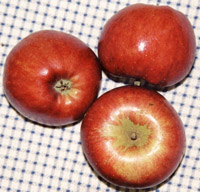 |
HERRING'S
PIPPIN A dessert apple introduced in 1908 by Pearson’s
of Nottingham having been raised by Mr Herring from Lincoln. Large bright
red fruit, becoming dark red, with a spicy flavour, delicious to eat raw
but sometimes also used for cooking. Ready in September or October, when
the lemony flavour has a hint of bananas, the flesh is sometimes red streaked.
It keeps for a month or so. Pollination Group 5 |
||
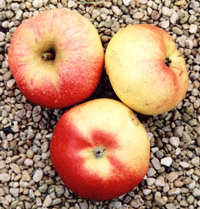 |
HEUSGEN’S GOLDEN REINETTE Bunyard (1920) tells us that this apple was raised by Pastor Henzen, at Elsen in Westphalia, and named after the pomologist Peter Heusgen. It was introduced about 1877. A rich dessert apple, with red flushed skin and fine-textured yellow flesh. The flattish shape and bright colouring of the apple is quite attractive. Ripe in October, the fruit is very sweet, rich and juicy, and will store, with care, into the New Year. Good crops. Pollination Group 6 |
|||
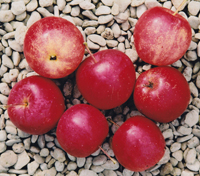 |
HEWE’S
CRAB Also known as Virginia Crab and Hewe’s Virginia Crab,
it is believed to have existed before 1730 in Virginia. Though there is
no historical evidence that it was grown in this country, it was certainly
known to Lindley when the American edition of his ‘A Guide to the
Orchard and Fruit Garden’ was published in 1846. The American editor,
Michael Floy, added it saying ‘this apple is of small size; form
nearly round; the stem long and thin; the skin is dull red mixed with
faint streaks of greenish yellow; the juice acid and austere; the flesh
singularly fibrous and astringent’. The American author, William
Coxe, in his famous treatise ‘A View of The Cultivation of Fruit
Trees’ in 1817, believed it originated in Virginia. ‘From
this apple is obtained the celebrated crab cider, which by some amateurs
is much sought after.’ Coxe found trees nearly 100 years old in
1817 which bore abundantly. Calhoun’s Old Southern Apples called
it the most celebrated cider apple ever grown in the South, making a dry
cider unsurpassed in flavour and keeping ability. He says the fruit is
late, small, hard and falls without bruising. The pulp is tough but gives
up its juice readily and the ‘must’ runs from the press very
fine and clear. The cider keeps all winter, clear and sparkling. George
Washington was a great admirer, preferring crab cider to any other. We
received scionwood of this important old apple from Philip de Palma in
Indiana and we are grateful to have it in this country. It fruits when
young, and in its first year the flowering appears to be early. The apples
here are brightly coloured and both blossom and fruit are quite impressive
to behold. Pollination Group 3 |
|||
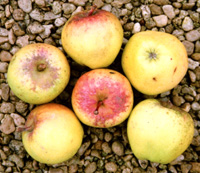 |
HILLGROVE
A curious old apple sent to us by Frances Bassom of Hillgrove Lane, Lurgashall,
Petworth, Sussex. The old tree grows in Hillgrove Lane. Frances informs
us that cider used to be made in quantity at the end of the lane in the
1920s/1930s and she thought this was one of the apples used. Several old
trees are in neighbours’ gardens. It would certainly be valuable
in cider but we also found it quite a rich apple to eat, being sweet,
juicy and with a hint of pineapple. The apples are small to medium sized,
green turning yellow and usually with half the apple covered in a bright
red blush that has prominet lenticels, giving the appearance of a strawberry.
The shape is fairly conical and with a hint of ribbing, especially around
the eye. The apples hang on the tree until Christmas and Frances warns
that they stay solid as a rock and that you can blunt your teeth on them
before they are ripe. “Even the fieldfares leave it until everything
else has gone.” Frances observes that the old tree has a lot of
burrs on the trunk and that it might be a “pitcher” type apple,
but that has not yet been investigated. Pollination Group 6 |
|||
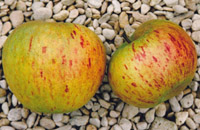 |
HITCHIN
PIPPIN First recorded in 1896, it was listed by the King’s
Acre Nursery early in the 20th century. It was described by Bunyard in
1920 and exhibited from Wisley and Kent at the 1934 Apple and Pear conference.
By 1946, when Taylor wrote of it, Hitchin Pippin was no longer listed
by nurseries and it disappeared in the modern age. It was not to be found
around Hitchin or wider Hertfordshire. Michael Clark of Tewin Orchard
eventually discovered an old named tree in Kent, though it has since died.
He took scions and kept it going, later providing us with a tree and some
scion-wood, for which we thank him. Bunyard described it as an ‘early
King of the Pippins’. An early dessert apple, medium sized, with
green-yellow skin streaked with crimson. Initially crisp, sweet and juicy,
(Bunyard says somewhat dry) the flesh is fairly dense, cream coloured
and with a good flavour. It is ripe in late August/September. The fruit
is oblong, with a flattened top and base, and the skin is orange, with
many streaks and flecks of bright red. By November it becomes soft and
the flavour fades. It spurs freely. Pollination Group 3 |
|||
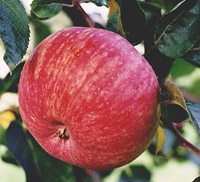 |
HOARY
MORNING An old Somerset apple known since at least 1819. It takes
its name from the hoary bloom of the skin, like that of a peach. Rogers
(1837) says that it was introduced to the London nurseries by a Mr Whitley,
of Fulham. Medium to large apples, with a greenish-yellow skin, prominently
striped with deep red and with sweet, rich flesh which is used for cooking,
when it will keep its shape but is also a good eating apple. Keeps until
Spring. Good crops. Pollination Group 4 |
|||
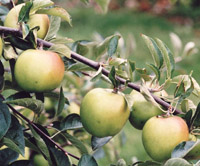 |
HOLLAND PIPPIN There are two distinct ‘Holland Pippins’ and this is the English one, of Lindley, Scott and Hogg. It was probably first recorded in 1729, though Evelyn noted it in 1664 if, as seems likely he was not addressing the Kirton Pippin, with which it has been confused. It takes its name from ‘the Hollands’ or the village of Holland, in Lincolnshire. Lindley’s description is as good as any - above middle size, of a somewhat square figure, the eye small with a closed calyx in a narrow, regularly plaited, basin. The stalk is short and rather deeply sunk, in a wide funnel shaped cavity. The skin is yellow green, interspersed with a few green dots and tinged with pale dingy brown on the sunny side. The flesh is yellow-white, pretty firm, tender and subacid, mixed with a good deal of sugar and having a slight perfume. In use from November to January, it is a sweet and very pleasant eating apple and we find it breaks down quickly to a purée, when cooked, with a rich taste and having developed a good lively tang, sweet enough without the need for sugar. It has also been used as a cider sharp/bittersharp, when young. The trees are vigorous with a spreading habit. Pollination Group 5 | |||
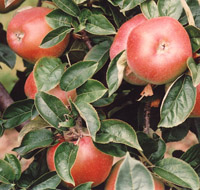 |
HOLLANDBURY
This is probably a very old apple (judged by the number of synonyms
it has acquired), though its recorded history begins in 1799. Forsyth
(1810), calling it Hallingbury, says, “This is a large flat-shaped
Apple, with large ridges from the base to the crown. It is of a beautiful
red toward the sun, and of a yellowish colour on the other side and toward
the eye.” He also describes Kirke’s Scarlet Admirable in the
same chapter, but differently. Confused early on, both apples have since
been assumed to be the same. Hollandbury has become the accepted name.
It has been grown widely in both the north and south of England, and Scotland.
It is a large, mid to late season cooker, going to a purée. After
storage it is sweet enough to eat and has also been used as a cider sharp/bittersharp.
Apples keep into November. The flesh is tender, white, sweetish but predominantly
acid. Trees are vigorous. Pollination Group 3 |
|||
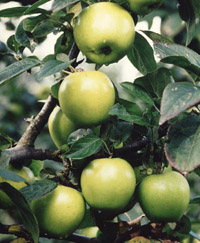 |
HORMEAD
PEARMAIN A late season, dual purpose apple believed to have been
raised at Hormead, in Hertfordshire and first recorded in 1826, when in
the first collection catalogue of the London Horticultural Society, though
Loudon, in ‘An Encylopaedia of Gardening’ (1824) thought that
it dated back to 1800. The flesh is white, crisp and juicy. The fruit
is good to eat fresh but also stores well, staying firm for several months.
It is also useful for cooking, when it retains some shape. The trees are
of moderate growth and crop well. Pollination Group 4 |
|||
HORNETT’S
HALL GOLD A full bittersweet cider apple. The single old tree
grows at the front of Hornett’s Hall, on the Hatfield Estate in
Hertfordshire. The current house is of the 1800s but the origin is probably
much earlier. This place lies next to a Norman farm and the tree was probably
once part of a cider tree orchard that ran down to the Candlesticks public
house, with other cider trees found closer there. A change in the entrance
arrangement now puts this tree in front, rather than behind Hornett’s
Hall. Research into this old orchard continues. A medium sized, rounded,
slightly flat apple that is yellow when ripe in October, into November,
but with a fine golden blush when exposed to the sun. The apple can be
used for cider when young but it is rather harsh. Later it becomes sweet.
We await the first experience of the quality of cider it produces, but
it looks very promising. Pollination Group 4 |
||||
|
||||